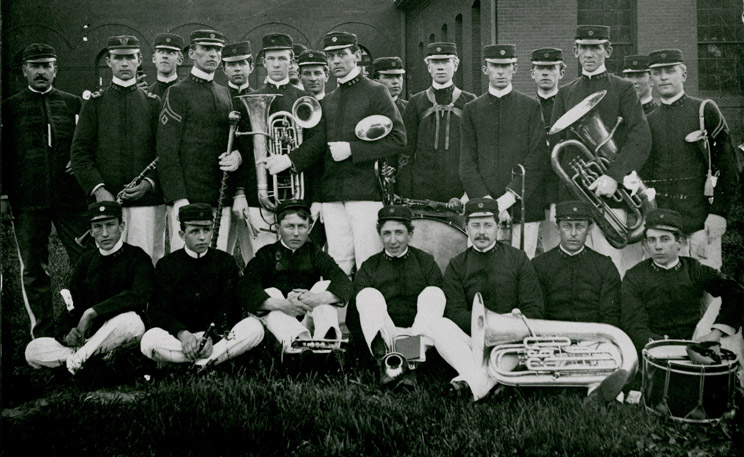This week, a patron asked if we could find out when the OSU Marching Band first played at a football game. We tracked down a likely answer in James Pollard’s “Ohio State Athletics: 1879-1959,” which also offered a wealth of hard-to-imagine tidbits about the early football program at OSU. (Because we don’t have many photos from the early days, we’ve decided to post a few images that help illustrate how far the program has progressed over the years.)
For instance, soon after intercollegiate competition started 1891, there were charges of brutality, the use of “ringers” (non-students) and – hard to imagine today – coaches playing on their own teams. It led to various college faculties to call for the abolishment of football. Luckily, nothing ever came of their appeals.
Training was also much different from the current regimen. Pollard quotes the Columbus Dispatch in describing a typical day of football training in the 1890s:
Every fellow rises at 7 o’clock and breakfasts at training table…on rare beefsteak, poached eggs, fried potatoes and dry bread. The forenoon hours are devoted to study and recitation and at noon an hour is spent rehearsing signals and individual practice… At 4 o’clock the men practice team work with the second University eleven until dark, when they take a run of several miles and then rub down, eat supper and go to bed.
Also unheard of for today’s football program was the gloomy financial picture The Wahoo reported for the 1892 season. (The Wahoo was the name of the student newspaper during a brief period of the early 1890s.) The newspaper gave figures showing estimated costs of $550 – more than double the estimated receipts of $250.
In 1893, three years after the football team was founded, the OSU Marching Band made its first appearance at the Oct. 21 game between OSU and Oberlin. According to Pollard, who was quoting The Columbus Dispatch, “the newly organized O.S.U. band” led a “parade of the city” on the morning of the game and gave a concert just before play started. Clearly the band was not nearly as effective as it is now; the football team suffered a 38-10 loss that day. Back then, of course, the band consisted of roughly a dozen musicians; today, membership tops 210 members.
Meanwhile, fans became so incensed at an early score by the Kenyon College team in the second half of a Nov. 30, 1892, game, that the crowd poured onto the field and tore down a portion of the fence. Pollard, quoting the Dispatch again, said “The game had to be stopped until the police cleared the grounds.” The crowd’s passion did not always lead to destruction: Two years later, after OSU won the Thanksgiving game against Kenyon, the Dispatch reported that “the crowd went crazy and carried the winners off the field.”








Recent Comments